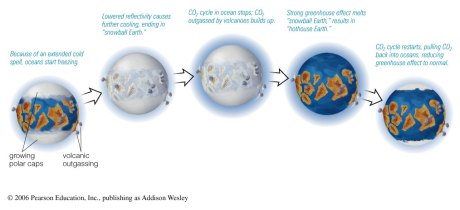Entwined Universe
March 28, 2011
Plate tectonics on Earth are heavily aided by the presence of water to weaken the integrity of the crust at subduction zones, and this lowered resistance helps oceanic plates sink below the lithosphere. Venus is approximately the same size as Earth, but it doesn’t have plate tectonics like Earth does. Some geophysicists like cite a myriad of variables that might determine whether or not an Earth-mass planet is active tectonically. Besides the presence of water, the thickness of the crust can determine the amount of resistance of a tectonic plate which will impact whether a plate will buckle or deform in the first place when it collides with another plate. A thicker crust is less likely to deform than a thinner crust. This is determined by how vigorous the internal convection of the mantle is, which is in turn determined by how hot the bulk of the planet is. A hotter interior causes convection of the molten material of the mantle to rise and sink faster, hitting the underlying material of the lithosphere harder and driving the movement of tectonic plates all the faster. Smaller objects like Mars or Mercury have a smaller mantle, which indicates a lack of a supply of fissionable elements in the core, and this means less radiogenic heat is produced from the breakdown of heavier elements. For these smaller planets, the mantle cools faster than an earth-sized planet and as the mantle hardens and cools, the crust gets thicker and tougher to subduct. So plate tectonics on a smaller planet shuts down earlier in that planet’s history, which leads to a whole host of problems for habitability. The tectonic cycle regulates (p.758) the amount of carbon dioxide and sulfur dioxide on the surface of the planet, so shutting down this system is disastrous. Carbon dioxide and sulfur dioxide build up, resulting in either an increase of these gases in the atmosphere or the crust.
Areios has a much hotter interior, which keeps the crust from forming too thick and pushes the tectonic plates so quickly that any crust generated from mid-ocean ridges would get recycled into the mantle quickly. This tectonic cycle is a fast-forward version of Earth’s tectonics, so carbon dioxide would get scrubbed from the atmosphere by hyperactive plate tectonics faster than volcanoes could spew it out. During a period of maximum glaciation, ice covers the continents, weighing down the plates and halting the process that scrubs carbon from the atmosphere. This builds up a greenhouse effect that eventually overcomes the frozen climate. It’s not until the end of a disastrous ‘Snowball’ period (p.759) that carbon dioxide levels rise to support planet-wide photosynthesis. More on that later…
The atmospheric composition of a planet is determined in part by the geology of the crust. As we’ve seen before, on Earth and Areios, carbon dioxide in the atmosphere gets pulled out of the air by minerals in the crust that get dragged back into the mantle by tectonic forces. But this isn’t the only way that the crust influences the composition of the atmosphere. When Areios was first forming, volcanoes would spew out water vapor and other volatiles that would eventually condense into the oceans. To be sure, just like on Earth, some of the water on the planet’s surface was delivered by ice-bearing comets (p. 752) and meteorites, but a significant amount of the planet’s early atmosphere was baked out of the crust. Like carbon dioxide, sulfur dioxide is released into the atmosphere by volcanoes, but because SO2 is so reactive, it doesn’t stay in the atmosphere like carbon dioxide does and is scrubbed out of the atmosphere quicker. This chemical exchange between the rocks and the air is only made more complex by adding the chemical reactions associated with life. Our instruments may one day be able to detect the presence of life based off their biosignatures it leaves in the atmosphere; the discovery of oxygen or methane in abundant quantities would all but confirm the existence of life there.
These interactions with the crust keep the composition of the atmosphere on Earth and Areios constant. However, in the history of both the Earth and Areios, a single prolonged episode in geologic history shot millions of tons of oxygen gas into the atmosphere. This may be the single most significant event in the history of life on these terrestrial planets because it means the rise of the complex organisms and eventually the humans and the Areia, but also it spelt the demise of any anaerobes that couldn’t seek refuge in an anoxic environment. The Great Oxidation Event may have been a mass extinction for anaerobic life, but it leads to the creation of the most recognizable organisms on our planet; the Eukyotes.
